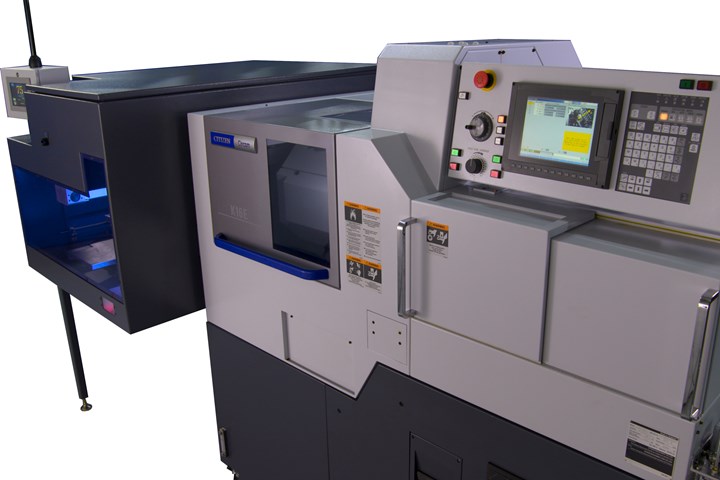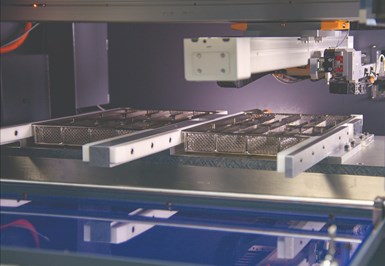Machining critical parts often requires intermittent inspection to ensure machined part features are within tolerance. When producing high-volume jobs on a Swiss-type lathe, it is often necessary to inspect parts at various stages of a run. However, stopping the machining process to do this is not optimal. Therefore, one Swiss-type lathe OEM developed a solution to enable in-line inspection on some of its newer machine models by adding an unloading and palletizing system for small parts.
This automated system, which is available on L Series Swiss-type lathes from Marubeni Citizen-Cincom (MCC) — including L220, L320 and L12 models — is designed to pick up a completed part that is typically 0.375-inch diameter or smaller and no longer than 6 inches, and then carry it to an external palletizing system. From there, it is deposited into a collection bin for inspection or a multilocation pallet for job segregation.
With the ability to inspect one part, an operator can know quickly when parts are out of tolerance so immediate action can be taken on the machine to adjust for tool wear or address other issues that are causing parts to be out of tolerance.
The unloading and palletizing system also offers flexibility for jobs that might need segregation. “You can drop two parts in one bin of the pallet and three parts in another bin, depending on certain order quantities for certain customers,” says Jim Cepican, sales manager for the accessory group and general manager of New England operations at MCC.
This automated unloading and palletizing system is designed to pick up a completed part that is typically 0.375-inch diameter or smaller and no longer than 6 inches, and then carry it to an external palletizing system. Photo Credits: Marubeni Citizen-Cincom
The first unloading and palletizing system created by the MCC automation group was prompted a few years ago by a customer who asked for a way to extract raw bone screws from the company’s Citizen-Cincom Swiss-type.
“First, he wanted to segregate their screws by batch, and then he wanted to ensure that there was no part damage,” Cepican explains. “So, our team came up with this system.”
After successfully engineering and implementing that first order, Cepican says MCC received an order at IMTS 2018 for multiple machines for this new (at the time) unloading/palletizing system. Since then, that customer has invested in several more of these systems. Cepican says there are other customers who have multiple systems, while others have two or three.
A Gripping Concept
The system’s design is based on automation to provide an ongoing process when a shop has limited personnel. Therefore, there is no need for a human to collect the completed part. One operator can load, unload and run multiple machines simultaneously when this unloading and palletizing system is integrated on a machine.
The palletizing system commences its job after a part is complete on the Swiss-type lathe on which the unit is attached. The machine’s subspindle delivers the completed part to a gripping device. Then, the gripping device transfers the completed part to the external dual-palletizing system where parts are deposited into a preselected collection bin. Part quantity per bin is programmable via the system’s human-machine interface. When a pallet is filled according to the program, the tower light on top of the unit alerts the operator. At that point, the operator removes the full tray for parts cleaning or further inspection, while the other empty tray continues to collect parts. Therefore, the machining process is not interrupted.
The machine’s subspindle delivers a completed part to a gripping device, which transfers the completed part to the external dual-palletizing system where parts are deposited into a preselected collection bin.
When the operator needs to inspect a single part, he/she presses a button on the system that drops the part into an external collection location, providing easy access to the part to be inspected.
Typical Tweaks
Cepican explains that the MCC group at its New England facility has a staff of engineers that is designing each unloading and palletizing system, working with the customers and distributors. “For customers that have multiple units, we train our distributors how to install and troubleshoot the system, providing local support,” he says.
Although all the unloading/palletizing systems that MCC create perform the same operations and have a standard cabinetry design, Cepican says that each unit is made with slight differences, depending on the type and size of parts being handled by the machine shop purchasing the unit. These differences can include gripper fingers, tray sizes and vacuum extraction pressures.
Also, an inspection system can be added to the system, if desired. According to Cepican, the OEM has built a system for a customer that is designed for a completed part to be deposited into an inspection station. After it is inspected, the part is transferred via a conveyor belt to a collection bin.
The system can be retrofitted on the existing L series Citizen-Cincom machine models as well.
Marubeni Citizen-Cincom Inc. | marucit.com
Related Content
Does a Scanning Probe Make Sense on a Swiss-Type?
Swiss-types have limited tooling capacity, but there can be advantages to giving up some of that capacity to take advantage of a touch probe — in fact, a scanning probe — to enable in-process part measurements.
Read MoreStories of Swiss First Additions
A handful of shops share their stories about the how’s and why’s of adding their first Swiss-type CNC turning centers.
Read MorePursuit of Parts Collector Spearheads New Enterprise
While searching for a small parts accumulator for Swiss-type lathes, this machine shop CEO not only found what he was looking for but also discovered how to become a distributor for the unique product.
Read MoreMoldmaker Finds Value in Swiss-Type Machining
This multifaceted manufacturer has added CNC sliding-headstock turning technology to complement its established mold tooling production and new injection molding capabilities as it continues to pursue complex medical work along a vertically integrated path.
Read MoreRead Next
Automation Brings Reliability to Laser Marking Bone Screws
To overcome human error in laser marking, consider a reliable, high-throughput automated system designed to run 24/7.
Read MoreVIDEOS: Tips for Screw Making on Swiss-Type Machines
Here’s a three-part video series focused on Swiss screw making to help explain the benefits of thread whirling, back turning and broaching while taking into consideration CAM programming, tooling and machine specifications.
Read More











.jpg;maxWidth=300;quality=90)











